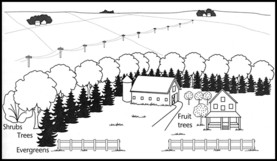 Windbreak on the Plains: North and west sides are protected, south is left open. There are three rows. Shrubs on the outside, deciduous trees next, finally evergreens. Fruit and flowering trees are planted inside where they are protected from the wind. |
When trees have ample room, they spread more and grow into the broad giants we are accustomed to seeing along rural roadsides and in parks. Given enough room, each kind of tree matures to a certain size and a certain shape determined by its genetic makeup. Maples, for instance, often grow to be 100 feet tall. They should be spaced about 40 feet apart for optimal growth. Other large-growing trees such as oaks, beeches and planes need similar elbow room.
Small-growing trees such as crab apple, dogwood and cherry may be spaced 20 feet apart. They will not need more space, no matter how old they become. They are useful near buildings, where their size remains in scale with the architecture and their roots don’t intrude into pipes or foundations.
Low-growing trees solve a very expensive municipal problem. Trees that grow too tall under electric wires become a safety hazard. They have to be pruned to protect the wires from damage and from breakage in storms. As often as they are pruned, new shoots appear, and they have to be pruned yet again in a few years. The pruning process is constant and very, very expensive. Herbicides that slow growth are helpful but also cost money and time. In the past, planners did not take this expense into consideration when planting street trees, so many cities are saddled with big street trees and high pruning costs.
A word of caution: Each kind of tree has many varieties. Each variety has its own genetic makeup and its own height. For instance, a sugar maple may grow to be 120 feet tall, but a Japanese maple with rarely reach above 20 feet, even when it’s a hundred years old.
Windbreaks
When trees grow very close together, their growth pattern changes. As they reach for light, they grow taller and faster and branch less. Their overhead canopy will be high, where it can catch the sun. Trees planted in this way function well as windbreaks. Rows of trees serving this purpose are commonly seen on farms protecting citrus groves and on the prairies serving to break the persistent strong winds that sweep across the flat, open land.
Good windbreaks usually consist of densely branched plants that break up the force of the wind. Many small branches and twigs combined with some evergreen material to do the best job. The windbreaks are placed to block the prevailing and winter winds. In most areas this is to the north and west.
On the prairies, growing conditions are very harsh and not all trees will survive or grow enough to make a good windbreak. The toughest trees have to be used.
Credit: www.mothersgarden.net




























